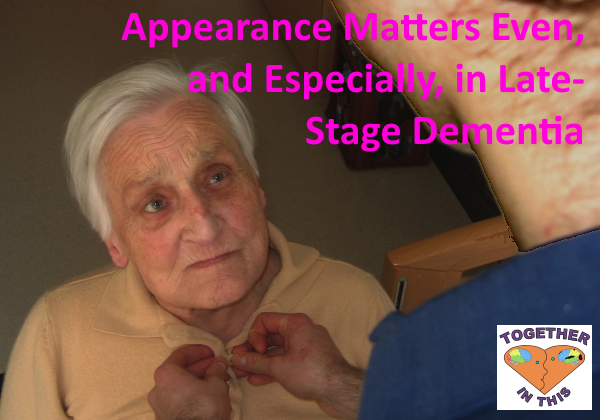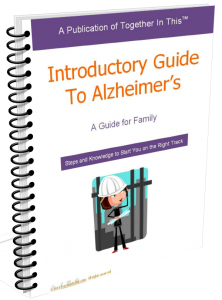Contributing Writer: Barbara Lewis, Limon Attire founder

When caring for our mother during the later stages of her dementia, my sister Catherine and I were determined to maintain her dignity and her identity.
Appearance and the fact that it still matters even in later stage dementia is rarely discussed in dementia care. There is little research on this important subject, yet it can have a great effect on both the person living with dementia as well as their carer/supporter.
Appearance can influence three areas – Dignity, Identity and Individuality.
Dignity
Appearance matters because it sends signals out and affects how people treat us. On an obvious level think about uniforms – they send out signals of identity, authority, institution etc.
It is the same with all our clothing – it tells people something about us and causes judgments to be made, whether consciously or sub-consciously.
Whilst most of us have a complete package by which we are judged such as speech, use of language, dress, demeanor, facial expression and body language, those in the later stages of dementia have often lost some of these faculties.
This can lead to assessment, and consequently treatment, based primarily on appearance.

Dining Drapron® with design facing wearer
When it came to having difficulty with eating there was no way that our mother was going to wear a ‘bib’.
She first used a napkin but as the need arose she wore an apron, something she had always worn and therefore was happy to wear and still looked dignified.
After observing her very carefully inspecting a pattern on one apron, I designed and made my own version where the patterns faced her rather than those looking at her; it was for her benefit, not ours.
I made sure that it was an effective clothing protector with a layer of toweling, and no unnecessary ties. They were a terrific success and were certainly not called ‘bibs’. The language we use also affects a person’s dignity.
Put anyone in ‘bibs and nappies’, and swiftly the person disappears!
Identity & Individuality
Our dress is part of our identity and individuality and affects how others perceive us – this is no less the case, and probably more so, for people with dementia. It is important for self-esteem and self-knowledge.
Often, when you look round a care home everyone starts looking the same, so it is as important to help retain the individuality of people in our care with their style as it is to take care of their eating, and other activities of daily living.
In the little research that I have found since my mother’s death – Professor Julia Twigg of Kent University found in her studies that “dress remained significant for people with dementia”.

Mum in coat she made
Our mother was a stylish lady and we always tried to keep it that way. This was as important for us as care givers as it was to Mum.
Taking care of her appearance and not having her dress just for our convenience gave her dignity and it helped remind us and others that she was still Mum. Quite late on in her dementia Mum was given a mirror when we had helped her dress and did her hair.
She peered at herself and managed to declare, “Oh I look quite normal!” It was clearly a concern to her that although she did not feel ‘normal’ she liked to look ‘normal’.
This was a time when she spoke very rarely, but how she looked obviously meant a lot to her.
Patsy Pope (Dementia Care Specialist from All about Dementia) agrees that “appearance has a HUGE impact on their wellbeing.” and “Get this aspect of care right and you will see them bloom with a renewed interest in their appearance and life in general.”

Mum – late on in her dementia
Consider how you feel when someone says to you “you’re looking lovely today.” It is the same for a person with dementia and that greeting will be reflected, leaving both caregiver and receiver feeling better.
Whilst some people with dementia lose all interest in clothing, another aspect of dress is that it becomes their “environment closest in” (Twigg 2010 Clothing & Dementia: A neglected dimension).
As the person loses some of their functions and their world becomes smaller, the things closest to them become more important and so their clothes need to feel and look good to them. Mum demonstrated this when she was closely inspecting her aprons.
So, as well as being attractive, I made sure her aprons were pleasant to the touch, which is not something that can be said about plastic or disposable ‘bibs’.
If you stop to think about it, if you know that your world is slipping away (and many of those with dementia do know what is happening to them), a sense of self is probably more important than at any other time in your life.
Even if that self-recognition lasts only a few fleeting moments, the knowledge that you at least appear to be your old self, matters deeply.
You can see the range of beautiful and dignified clothing protectors (Draprons®) that Barbara has developed at: https://www.limonattire.com/collections/dining
We are offering a special 10% discount on first orders to readers of Together in This. Quote TinT10 at the check out.
 About the Author:
About the Author:
Barbara Lewis cared for her mother for three years, along with her sister, in the later stages of her dementia.
Their creativity and problem solving skills helped them to keep their Mum at home (where she wanted to be) with dignity until the very end.
Barbara studied textiles and had a 20 year career in Fashion Buying and both sisters are skilled seamstresses like their mother. Since her Mum’s death she has worked hard to share with others her experience and the products she designed for her mum.
Be sure to visit Barbara’s store: Click Here.
If you like what you’ve read, why not receive periodic updates when you:
Subscribe to the TinT Newsletter
If you have questions or would like to share your experience, we’d love to hear from you in the comments below:






Thank you for sharing my article Mike.
And I appreciate you writing such an insightful piece 🙂
I LOVE the feel of this sharing! What a loving and beautiful way to honor our loved ones,! (our patients, our residents….). All the details of care in this article are magnificent! Barbara- how sweet of you to really step into your mom’s world and bring her this type of joy! One of my patients was one of the first woman executives hired by Grumman. I learned her wishes early on as her therapist and made sure that her hands were always manicured and lovely! This always made her feel beautiful! She also loved small silk scarves tied loosely around her neck— as care partners, caregivers , therapists., and clinicians, the joy of providing positive esteem care is very empowering!! Thank you!
Thank you for your comment and sharing your story; she was fortunate to have you caring for her 🙂
Thank you for your comments Marianna.
I have just had a look at your website too and love your thoughts on music and colour. My Mum’s Dining Draprons were always full of colour to give her some joy and music was n important part of her care and communication with her.
Loved your article.
Appearance DOES matter!
Thank you for your comment Wendy – It is good to know that others feel the same way.
This is great, Barbara. My mom cared for my grandma with Alzheimer’s the last 5 years of her life, and my grandma always looked pretty! Mom made sure Anna had her necklaces and bracelets and pretty blouses, always. And her lipstick! I’m certain it gave Anna a psychological boost.
I look forward to checking out your site. The clothing protectors used in long-term care are so ugly and plain (white terrry cloth); this is a genius idea. Especially how the design is facing the person…kind of a “duh!” now that you point it out.
Thank you for your comments Christy – you’re grandma was a lucky lady. and yes – it was rather a “duh” moment!!